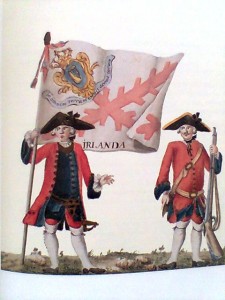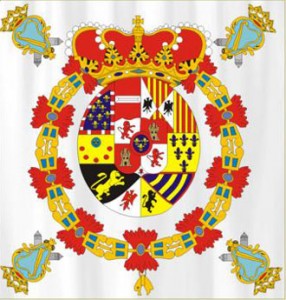General Michael (Miguel) Marmion, the Spanish Army and the Irish ‘Wild Geese’

Chevalier William F.K. Marmion, M.A. tells the story of his search for his ancestor and the Irish soldiers of Spain.
After the battle of Kinsale the subsequent conquests of Ireland by Cromwell and King William, the Irish nation indeed lost its natural leaders to forced emigration. That well-documented fact also wound up contributing to the poverty of the defenceless left behind. And why throughout the 17th, 18th, and even into the 19th century one of the only dignified options for an Irishman was to leave Ireland for service in a foreign army or navy.
Irish soldiers in exile
Collectively, the men who left were primarily soldiers and their services were highly desired by the sovereigns of all ‘catholic’ countries e.g. France, Austria, Spain. The women and children were primarily the dependants of the ‘Wild Geese’ soldiers. Large numbers of ‘Old English’ or Norman-Irish nobility also left Ireland, their departure accelerating after the Cromwellian and Williamite wars. The invader had lumped them totally with the Gaelic-Irish as ‘Irish Papists’ and had confiscated the lands of Fitzgeralds, Barrys, or Marmions just as they had taken those of a MacCarthy or an O Cahan or an O Neill!
The very first Irish regiment of soldiers which went into Spanish service was that of Colonel William Stanley, an English Roman Catholic. They were followed by three more Irish regiments and by the 18th century and Irish Brigade, with three regiments.
For untold years I have worked on family history. I found much, and published what I’d found in several books and a number of articles. I knew about Marmion Spanish service through such as Brendan Jennings’ monumental Wild Geese in Spanish Flanders and references from British archives, etc. Thus I knew that there was a Marmion junior officer in the first regiment of Irish in Spanish service, 1587, and a Captain Dominic Marmion in the Flanders regiments of O Sullivan Mor and Colonel Murphy, mid-1600’s. Both were closely related to Captain Nicholas Marmion of the main Carlingford line, who died in 1598 at Carrickfergus. ‘Ole Captain Nick’ was an important figure in the early phases of the O Neill wars.
The very first Irish regiment of soldiers which went into Spanish service was that of Colonel William Stanley, an English Roman Catholic who had served in Ireland against the Scots, O Neill’s and O Donnell’s. In 1585-86 he recruited a new regiment which was composed mostly of Irish Catholics, many from Counties Louth and Down. The English sent it to Flanders to fight against the Spanish there, in alliance with the Dutch who were in rebellion against their Spanish overlords.
But in 1587 Stanley and his regiment ‘went over’ to the Spanish and served admirably. This was the regiment in which served a Marmion ancestor. The regiment was dissolved by 1604 and from then began the recruitment of new regiments of Irish exiles into Spanish service, named after their commander, e.g. O Neill, Preston, Murphy, etc. Some of these regiments saw long service, some short service, depending upon the exigencies of the wars of the Spanish.
Before the early 18th century individual regiments were no longer recruited as the Spanish formed a single Irish Brigade as part of the regular army, which had three regiments (Ultonia or Ulster – 1698, and Irlanda and Hibernia formed in 1709). The Irish Brigade lasted until its disbandment in 1818.
Searching for General Miguel Marmion

There is a new on-line resource called The Irish in Europe Project, which catalogues 40000 Irish migrants to European countries, mostly ‘Wild Geese’ soldiers. All the data is included in the VRE (virtual research environment. It is accessible at www.irishineurope.ie/vre/collection/index.
When the listings of the Irish in Europe Project went on-line, I checked for Marmions and found a new person I had never come upon: identified on the site as Lieutenant Colonel Michael (Miguel) Marmion, and showing his service as 1770-1799. Getting on to the specific further entries about him I found that he was born in ‘Ireland’ and the listings of his regiments showed two in what is now South America, then in Spanish possession.
Colonel Michael (Miguel) Marmion, served in the Spanish Army from 1770 to 1799.
Most importantly, the information showed where what was published came from, in his case, from the Spanish Military Achives – which is located at Segovia in Spain. Further enquiry confirmed that they indeed held the complete service file of Miguel Marmion! The archives sent me over 50 pages of information about his service and life.
His was listed as being of birth, ‘noble’, and ‘distinguished’. This was necessary for all Irishmen wishing to be officers in the Spanish Army, as it was for the Spanish applicants. As a Marmion he indeed was armigerous and had noble ancestry per family history.
Only those Irishmen actually recruiting regiments were required to submit their nobility proofs to the Spanish. But the Spanish assumed that the head of the regiment would choose his officers from only those of ‘distinguished’ birth – which indeed was the case in the Irish regiments from individual officer identifications. An individual Irishman entering Spanish service directly, such as Michael (Miguel) Marmion did, was however required to submit his pedigree directly to the Spanish government, in the same manner as Spanish applicants for officerships.
The file pinpointed his birthplace as DUNDALK, which immediately tied him to my specific ancestry as I had indeed expected. Further, he came to Spain very young, about 1746 (born 1736), brought by a ‘noble relative’. He entered the Army by being enrolled in the Spanish Military Academy of Mathematics at Barcelona in 1758, from which he graduated as a sub-lieutenant of Engineers in 1762. He went into the regular Spanish Army given his graduation from the Military Academy primarily for engineers.
From Dundalk to Caracas
Colonel Marmion served as Governor of what is now Venezuela, settled there and died in Cuidad Bolivar 1818.
After serving in a few different regiments in Spain to include one in Mallorca, he left for the ‘colonies’ in late 1768 as a Captain. He had married in 1768 Tomasa Villamayor, the daughter of a Spanish Colonel and there are 4 or 5 pages dealing with all the permissions which had to be obtained for an Army officer to marry, from the father of the bride right up to the Minister of War acting for the King of Spain. When overseas, Miguel/Michael was headquartered out of what is now Caracas, Venezuela but he was actually mainly located in the colony of Guyana. He was promoted Lieutenant Colonel in 1779, Colonel in 1789, and served as ‘Governor’ of the colony from 1785 to 1790.
He then served as Chief Engineer of all the areas dependent upon Caracas, travelling to several islands, Florida, Cuba, etc. He was promoted Brigadier General in 1794 and retired in 1800 with 42 years of total service, age 64. He stayed in the ‘colonies’ and there is a school named after him in what is now Ciudad Bolivar in Venezuela. He died ‘without succession’ in 1817-18, his wife apparently having predeceased him. There is an, ‘informes’ in the file about inquiries being made by his two (claimed) ‘closest’ relatives, Patrick and Thomas Marmion who wrote from Dundalk. Naturally, it was about any estate Michael/Miguel had left! There is nothing more about how all that worked out for the areas where he lived were no longer under Spanish control by 1817-18, having achieved independence.
Again, all this just from finding a man in the Irish in Europe listing! And obviously what I now have opens many more doors and begs answers to new questions about his life, his exact line in Dundalk (which I am certain I can identify from my own work over the years), his relation to the previous Marmions found in Spanish service, etc. There are several of his signed reports in the file relating to the on-going fighting/arguments with the British and the Dutch about the boundaries of Guyana, etc. And I’ve found there is much more of his correspondence in British archives. And yes, did he ‘go over’ in late life to the independence movement led by Simon Bolivar? It would seem so as countries don’t name schools after those who fought against them – there is no Kaiser Wilhelm school in England!
So, we have a lot more but now there is much more to search out. The key is that the identity of this man is now clear, and future family historians can pursue the genealogical and historical paths.
All thanks to the Irish in Europe project. I heartily recommend going to the site and typing in your surname. You may just turn up gold.
Appendix – the Irish in Europe Project
There is a new on-line resource called The Irish in Europe Project. It will be of interest to all those who have ‘Wild Geese’ ancestors who left Ireland between 1580 and 1800, to serve in the armies of France and Spain in particular. It will be of especial significance to descendants of the Irish nobility given that the leadership of the regiments and the officer corps was almost exclusively composed of those of noble families forced out of their native country by the invader.
The ‘Irish in Europe Project’ was conceived at the National University of Ireland, Maynooth, in 1997. The subsequent research by scholars at Trinity College, Dublin, and by those in France, Spain, Belgium, etc. has resulted in a current base of 40000 Irish migrants to European countries, mostly ‘Wild Geese’ soldiers. All the data is included in the VRE (virtual research environment) created on-line.
The project gives individual name identifications of Irishmen and Irishwomen. The website is accessible at www.irishineurope.ie/vre/collection/index. You will then find two military groupings (at this point in time): French Military (16000 entries), Spanish Military and Community (15000 entries) The Spanish group is labeled ‘community’ because most of the entries relate to Irish service in what was Spanish Flanders (now roughly Belgium and Holland) from 1580. For a century or more there was a virtual Irish ‘community’ in Flanders, to include marriages, births, Irish cultural activities, interactions to and from Ireland, etc.
Additionally, the Irish in Europe website has groupings for Irishmen who studied for the priesthood as that was impossible in Ireland itself given the penal laws against the Catholic religion. So there are lists of Irish students in the Irish colleges established at Paris, Louvain, Toulouse, Alcala in Spain, etc.
In net, there are real pickings from this initiative for those of who indeed have ‘Wild Geese’ ancestors. And a discovery always leads to many more roads being opened. It will cover the discovery of an hitherto unknown ancestor in the Spanish Army and what was uncovered about him, starting from the Irish in Europe webpage.